This is the first topic moving away from molecular biology, instead looking at life from a wider perspective. Ecology is the study of the relationships between living organisms and their environment. I would assume that this is usually a well-received chapter because there is not really a lot to it besides reading and remembering. However, it is a chapter which opens to a lot of expeditions out in nature to collect data for sampling. I would think that most of the material in this topic makes sense, but a tip I would give is to visualize the various cycles to make it easier to remember. I would also make sure to be familiar with the reactants and products of photosynthesis and cellular respiration.
Points for revision:
-Autotrophs, heterotrophs, and saprotrophs
-Producers, consumers, decomposers, and the nutrient cycle
- Food webs and trophic levels
Autotrophs, heterotrophs, and saprotrophs
An autotroph is any organism that is capable of producing its own food by photosynthesis. Most plants and algae are autotrophs. In a food chain, autotrophs are called producers.
A heterotroph is any organism that cannot produce its own food, and therefore has to get energy and nutrients through consuming other organisms. Most animals are categorized as heterotrophs. Heterotrophs can consume both live and dead organisms. Detritivores lives by consuming dead organic materials. In a food chain, heterotrophs are called consumers.
A saprotroph is any organism that gets it food by decomposing other organisms. Fungi and bacteria decompose living organisms by chemical digestion using enzymes. In a food chain, saprotrophs are called decomposers.
Producers, consumers, decomposers, and the nutrient cycle
An ecosystem is the interactions between organisms and biotic and abiotic factors in their environments. In order for an ecosystem to be sustainable, it has to be able to recycle material to be used again. One example of a cycle in an ecosystem is the nutrient cycle. Primary producers can make organic glucose from inorganic carbon dioxide by photosynthesis. Glucose and other nutrients are then stored inside the producer. When an organism consumes the producer, the glucose and nutrients are transferred from the producer to the organism. Organisms consuming other organisms are called consumers. Finally, the nutrients from the consumers must be recycled back to the producers to make a cycle. In comes the decomposers. Decomposer recycles the nutrients from dead organisms to be taken up by producers, by secreting enzymes that can chemically digest organic molecules to molecules more useful for itself and producers. The producer can then take up these molecules and start the cycle over again.
Food webs and trophic levels
A food web is a visual representation of how species are interconnected and dependent on each other, and how energy flows though ecosystems. It is essentially a collection of individual food chains all liked together. Trophic levels in the food web determines the function of the organism. The first trophic level are the primary producers. Producers can turn inorganic material into organic material through photosynthesis. The name comes from the fact that they produce energy for the next trophic levels. It is the fundament for all the other trophic levels, and no consumers could have survived if it had not been for the producers. The second trophic level is comprised of the primary consumers. They are categorized as consumers because they cannot produce their own energy and therefore has to get energy through consuming other organisms. Primary consumers consume producers and are therefore called plant eaters or herbivores. The third trophic level are the secondary consumers. They get their food by consuming primary consumers and are thus called carnivores. Secondary consumers are usually predators because they have to hunt their prey. The fourth trophic level is usually the highest trophic level due to the energy pyramid, and it consists of the apex predators. This means that it hunts other organisms, without being hunted itself. A food web can be seen as an energy cycle, because when the consumers die, the decomposers recycle their nutrients for producers to take up and start the cycle all over again. An organism can belong to more than one food web as they are all interconnected in an ecosystem.
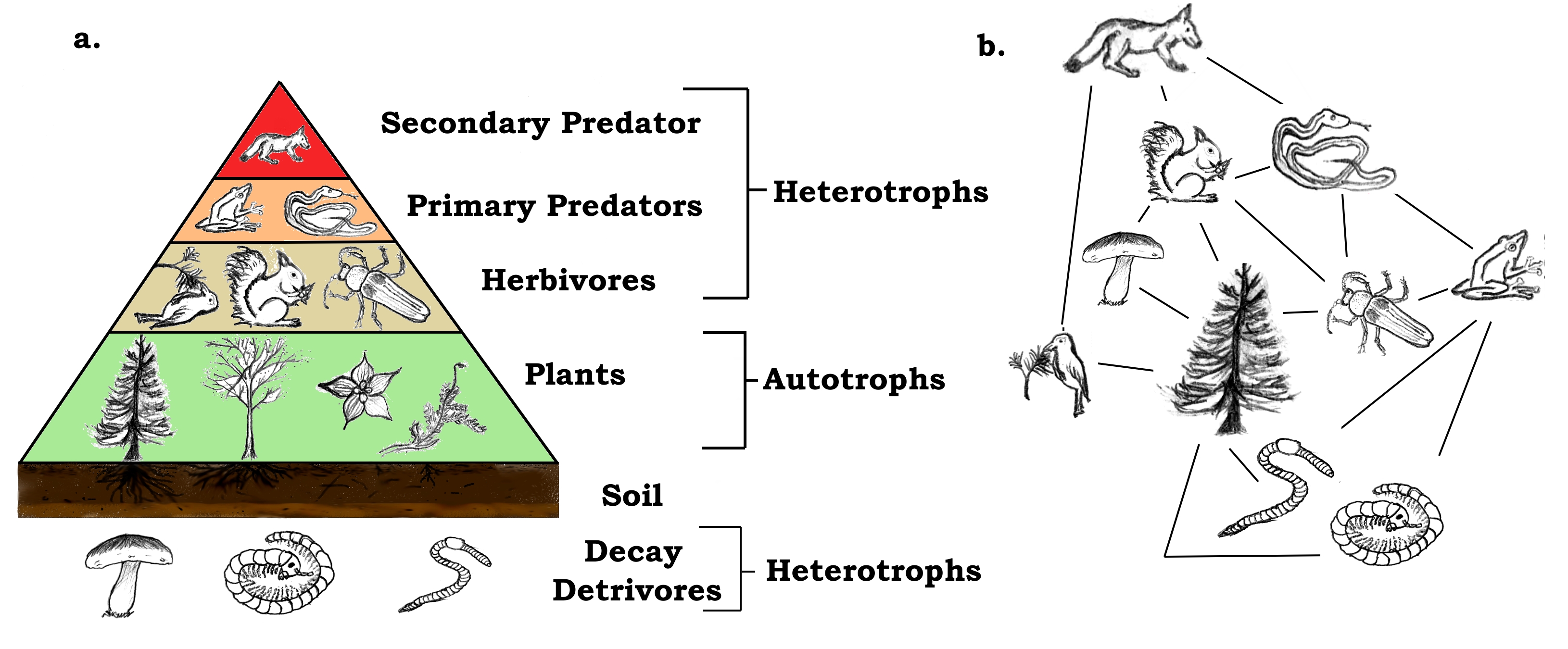
Energy pyramids:
Heat cannot be recycled, so the earth is dependent on the sun as a source of energy. Since heat cannot be recycled, the heat energy produced by cellular respiration is lost. Because cellular respiration is a continuous process in all living organisms, energy lost as heat means that only a fraction of the energy consumed, can be transferred over to a higher trophic level. In fact, only 10% of the energy consumed can be transferred. This is the reason why most food webs do not go beyond the fourth trophic level.
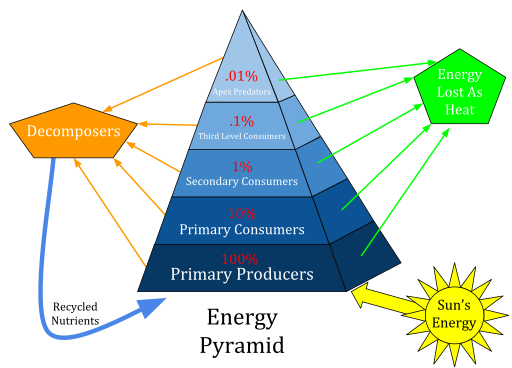
The carbon cycle
Carbon is the most central atom in organic chemistry, and it is essential for life on earth. Carbon is cycled continuously through organic and inorganic processes, providing material for photosynthesis, and released in cellular respiration, the two most important processes of life.
When a living organism dies, its remains are either decomposed by decomposers releasing carbon trough cellular respiration, or partially decomposed turning into fossil fuel. When this carbon is released into the atmosphere, either passively or by combustion, it is in the form of carbon dioxide. Carbon dioxide is then absorbed by producers and turned into organic glucose molecules through photosynthesis, which is consumed by consumers, starting the cycle over again.
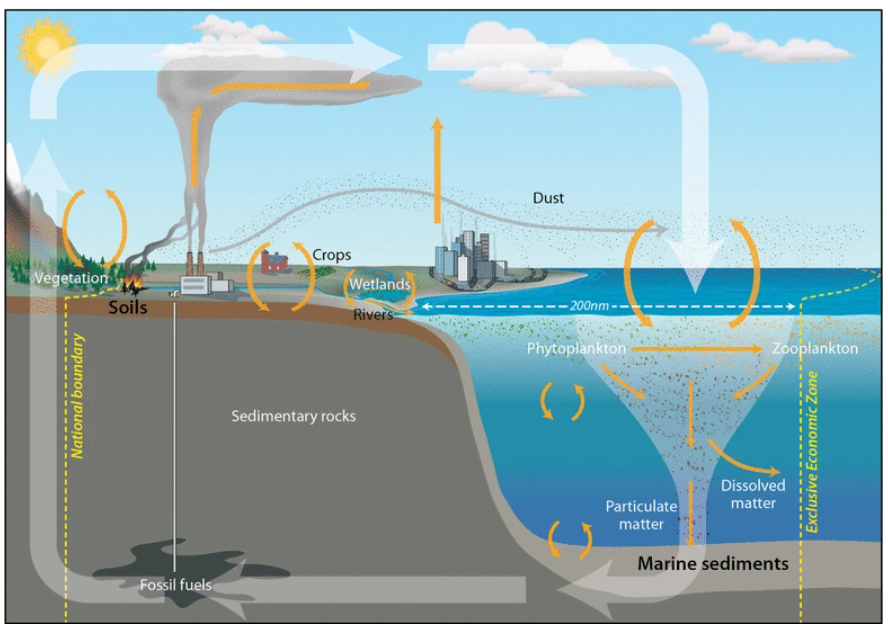
Fossil fuels
Fossil fuels are preserved decomposed organic material, and it comes in the form of for example oil, gas, coal, and peat. Fossil fuels are extremely rich in energy, but they take millions of years to make. The problem with fossil fuels is that although they are rich in energy, they release a lot of carbon dioxide during combustion, strengthening the greenhouse effect and global warming. The use of fossil fuel has been a hot topic for debate among teenagers and politicians in the past few years.
The greenhouse effect
The greenhouse effect is a necessity for life, and without it the earth would be inhabitable. However, in the last century or so, the greenhouse effect has spiraled out of control as a result of increased emissions of greenhouse gases. An increase of greenhouse gases leads to an increased temperature, resulting in a phenomenon called global warming.
When the sun radiates energy on the earth, most of it is reflected back into the atmosphere. However, some of the energy is absorbed by gases such as carbon dioxide, which reemits the heat energy back to the surface, thus leading to less heat loss and increased temperatures. This phenomenon is called the greenhouse effect because it is similar to the process happening in a greenhouse, and the gases reemitting heat are called greenhouse gases. The most known greenhouse gas is probably carbon dioxide, even though the most abundant greenhouse gas is water vapor, and even though methane is a much more effective greenhouse gas. The reason why carbon dioxide has sparked so much attention, is because increased emissions in the period after the industrial revolution has seen a strong correlation to a global temperature increase. Even a slight increase in temperature can have a significant effect on life on earth, and many of the world's leading scientists and politicians are working on finding a solution and solving the problem.

Chi square test
The chi square test is a statistical tool to see if there is any correlation between the expected value and the observed value. To be able to determine this, a null hypothesis is needed. A null hypothesis states that there are no significant statistical differences between the expected and observed values. An expected value is the theoretical value of an event. It would for example be expected to have a 1/6 probability to throw any value on a 6-sided die. The observed value is the value which is experimentally determined. It is not always the case that a 4 is thrown 1/6 times. The chi square test basically determines whether the experimental data fits with the theoretical data. To calculate the chi squared value, this scary looking formula is used:
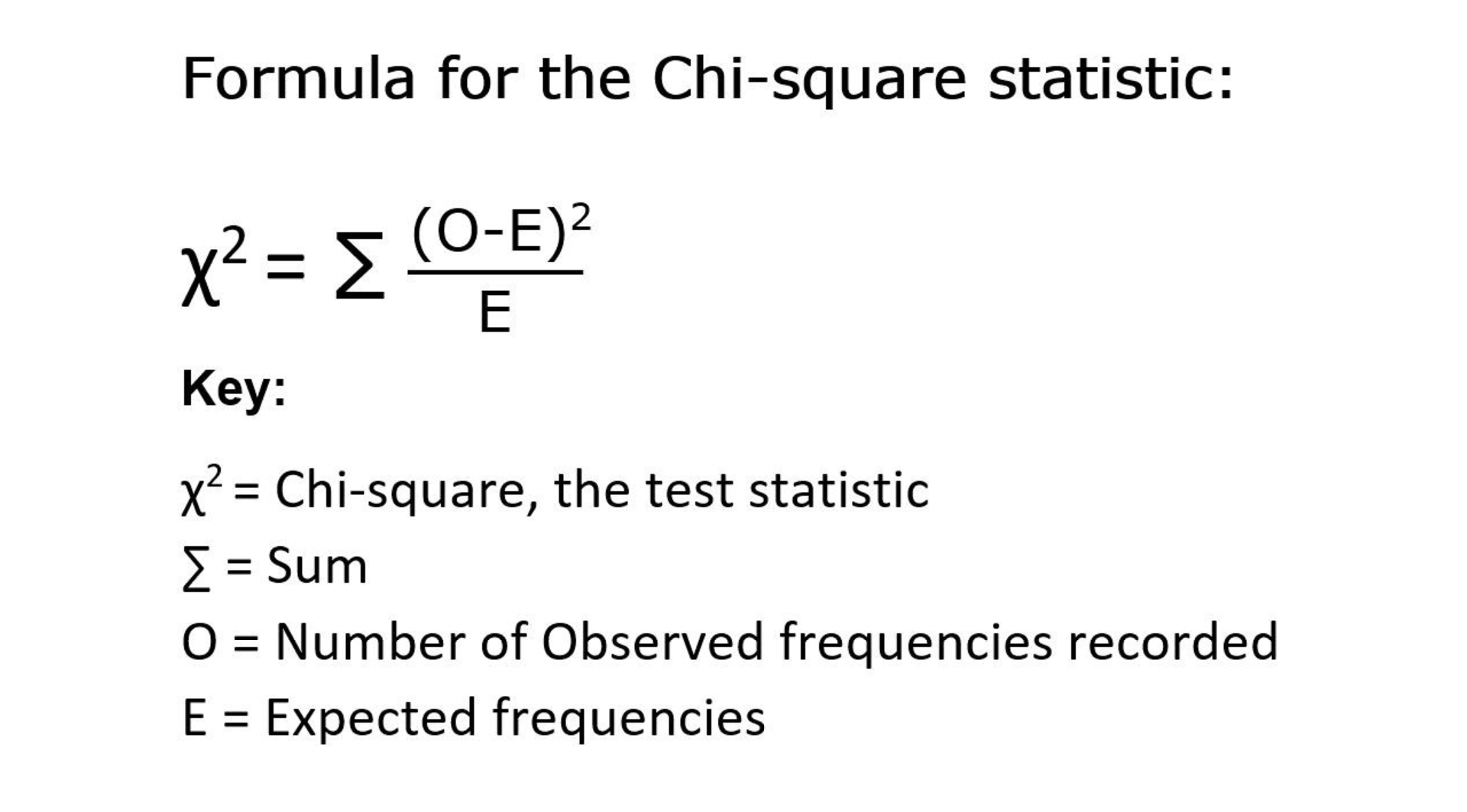
After putting in the numbers, a chi square value is spit out. We now need to compare this chi square value with a critical value. The critical value can be found with a table, but first we must determine the degrees of freedom which we have. The degrees of freedom are determined by the calculation: Possible outcomes – 1. When throwing a die, we have 6 possible outcomes, which turns into 5 degrees of freedom. We then compare value we got with the critical value. If the chi squared value is greater than the critical value, we have to reject the null hypothesis, but if our value is lower than the critical value, then we can accept the null hypothesis. I will do an example just to illustrate how this works.
Image that we are throwing a die 360 times and recording the outcome of each throw. We now want to figure out if there is any correlation between our observed value and the expected value, so we make the null hypothesis: There is no significant statistical difference between the expected frequency of values and the observed frequency of values. Now we need to calculate our chi square value:

After calculating our chi square value, we have to find out how many degrees of freedom we have. Since we have 6 different outcomes, we have 5 degrees of freedom. We then have to choose how accurate we want our test to be. A 5% probability of exceeding the critical value means that there is a 95% chance of not exceeding the critical value, which translates to that the test is 95% accurate. Looking at the table we can see that we are way under the critical value, which means that we can accept the null hypothesis, that there is no significant statistical difference between the values.
However, if our observed values are way different than the expected values, we can see that the chi square value far exceeds the critical value, which means that we have to reject the null hypothesis. In this data set it is clear that the probability of each outcome is not 1/6
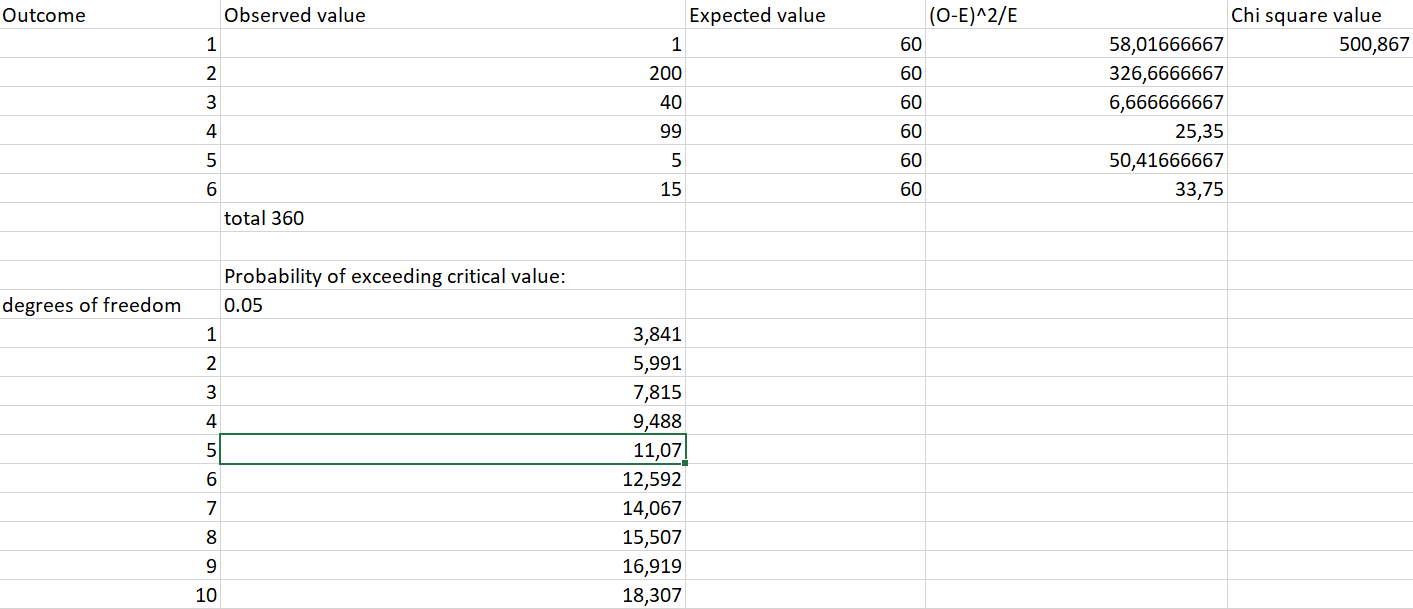
Helpful videos:
Food webs: https://www.youtube.com/watch?v=v6ubvEJ3KGM
Energy pyramids: https://www.youtube.com/watch?v=-oVavgmveyY
Carbon cycling: https://www.youtube.com/watch?v=Sd8D7WyVS6A
Greenhouse effect: https://www.youtube.com/watch?v=sTvqIijqvTg
I experienced this chapter as being reliant on previous knowledge, and it reintroduces the knowledge with the perspective of ecology. However, it did not find it as interesting as the previous chapters, even though it discusses what may be the most immediate problem of humankind i.e., global warming. It is therefore just my subjective opinion that I felt the previous chapters as more interesting.